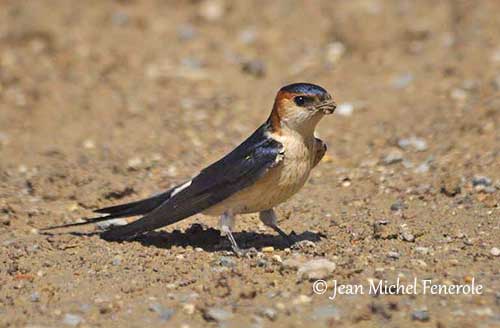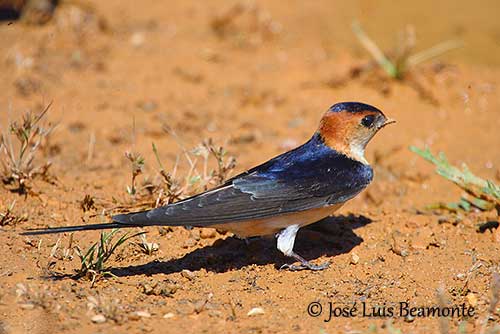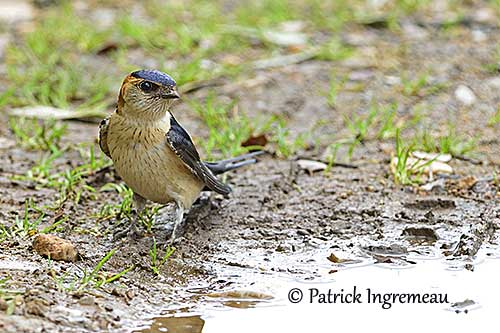
Fr: Hirondelle rousseline
Ang: Red-rumped Swallow
All: Rötelschwalbe
Esp: Golondrina Dáurica
Ita: Rondine rossiccia
Nd: Roodstuitzwaluw
Sd: rostgumpsvala
Photographers:
José Luis Beamonte
Pájaros de España
Jean Michel Fenerole
Photos d’Oiseaux du monde
Patrick Ingremeau
TAMANDUA
Jean Marc Rabby
Des Ailes et des Plumes
Nicole Bouglouan
PHOTOGRAPHIC RAMBLE
Text by Nicole Bouglouan
Sources:
HANDBOOK OF THE BIRDS OF THE WORLD Vol 9 - by Josep del Hoyo - Andrew Elliot - David Christie - Lynx Edicions - ISBN: 8487334695
THE HANDBOOK OF BIRD IDENTIFICATION FOR EUROPE AND THE WESTERN PALEARCTIC by Mark Beaman, Steve Madge - C. Helm - ISBN: 0713639601
ENCYCLOPEDIE DES OISEAUX DE FRANCE ET D’EUROPE – de Peter Hayman et Rob Hume - Flammarion – ISBN : 2082009920
A Field Guide to the Birds of South-East Asia by Craig Robson. New Holland Publishers. ISBN: 9781780090498
BIRDS OF AFRICA SOUTH OF THE SAHARA by Ian Sinclair and Peter Ryan - Princeton University Press Princeton and Oxford - ISBN: 0691118159
BIRDS OF THE MIDDLE EAST by R.F. Porter, S. Christensen, P Schiermacker-Ansen C.Helm - ISBN: 0713670169
Pájaros de España (JL Beamonte)
Wikipedia, the free encyclopaedia
Department of Sustainability, Environment, Water, Population and Communities
Red-rumped Swallow
Cecropis daurica
Passeriformes Order – Hirundinidae Family
INTRODUCTION:
The Red-rumped Swallow is placed in the subfamily Hirundininae that includes the typical elegant swallows and martins. The species of genus Cecropis show large amounts of rufous in their plumage, especially on head, neck and rump, and some species have streaked underparts. The tail is usually deeply forked.
The Red-rumped Swallow is the most widespread of this genus. It breeds across S Europe and Asia, to S Siberia and Japan. It is migratory and winters in sub-Saharan Africa and South Asia. Some populations are year-round resident in Africa, India and Sri Lanka.
The Red-rumped Swallow is generally common throughout its wide range, except in W and E Africa where it is locally common. The species is not globally threatened.

DESCRIPTION OF THE BIRD:
Biometrics:
Length: 16-17 cm
Weight: 19-29 g
The Red-rumped Swallow adult is very similar to the Barn Swallow with orange-rufous neck sides and rump. The buffy underparts show long, dark streaks. The underwing-coverts are creamy-buff, while the undertail-coverts are black.
On the upperparts, crown and back are glossy deep blue. They are separated by partial chestnut collar. The rump is chestnut to orange-rufous, finely streaked black. Upperwing and uppertail are blackish and slightly glossy. The outer rectrices are elongated, up to 3,5 cm.
The blackish bill is short and flat with wide gape. The eyes are dark brown. The short legs and the small, weak feet are blackish.
The female has similar plumage but she has shorter tail than male.
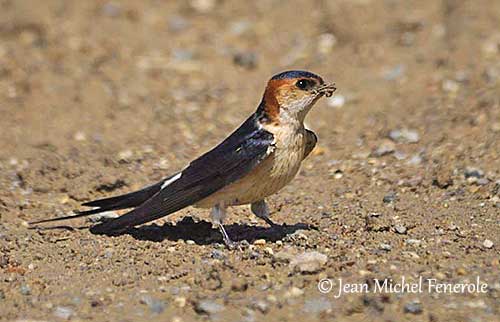
The juvenile is duller with browner upperparts, paler rufous areas and more indistinct streaking. The tail is shorter and the wing feathers are tipped buff.
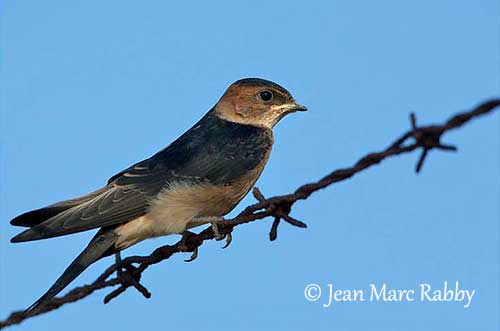
SUBSPECIES AND RANGE:
The Red-rumped Swallow has 10 subspecies that differ in extent of streaking on rump and underparts, varying from white to chestnut, and presence of collar on the hindneck.
C.d. rufula (displayed) breeds in SW and S Europe, including Spain, Portugal and Mediterranean countries, N Africa, E to S Asia Minor, Levant, NE Saudi Arabia, W and S Iran, Pakistan, NW India and Tien Shan. It winters in Africa and SW Asia. This race has pale rufous underparts, narrow streaks and complete collar.
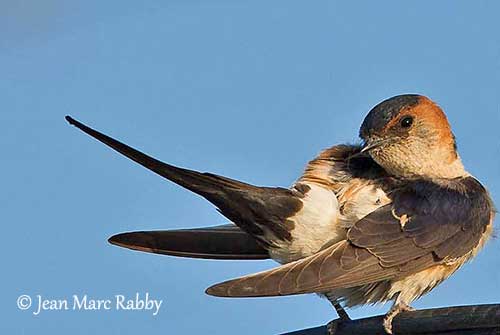
C.d. daurica (described above) breeds in NE Kazakhstan E to SE Russia and N inner Mongolia, S to SC China. It winters in S and SE Asia.
C.d. japonica breeds in E Amurland, NE, E and S China, Korea and Japan. It winters in SE Asia, S to N Australia. This race has indistinct streaking on rump, heavily streaked underparts and interrupted collar.
C.d. nipalensis breeds in the Himalayas and Tibet, and N Myanmar. It winters in India. This one has pale rufous, heavily streaked underparts.
C.d. erythropygia breeds in India, E to W Bengal and S. It winters in S India and Sri Lanka. This race has dark rump and buffy-white underparts.
C.d. hyperythra is found in Sri Lanka. This race has deep rufous underparts with faint or no streaks and indistinct collar. It is now a full species since 2011: Sri Lanka Swallow - Cecropis hyperythra
The 4 other races such as domicella, kumboensis, melanocrissus and emini are resident in Africa, in a broad belt from W Africa E to Ethiopia and S to Tanzania. They have little streaking and pinkish-buff to pale rufous underparts.
HABITAT:
The Red-rumped Swallow breeds in open or partly wooded country, in hilly areas and mountains, valleys, seacliffs, cultivated areas and towns. It builds its nest in caves, buildings, under rocky ledges and bridges. It usually avoids the dense forest, the wide open plains and the highest elevations. It usually occurs from sea-level to 800 metres, sometimes higher outside Europe.
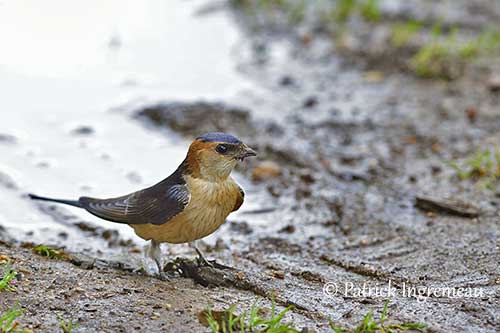
CALLS AND SONGS: SOUNDS BY XENO-CANTO
The Red-rumped Swallow gives House-sparrow-like chirp “tchreet” as contact call, and a nasal “tzueeee”. The alarm call is a sharp “kiir”.
The song resembles that of Barn Swallow but with lower-pitched twittering, mostly harsher, slower, shorter and more nasal.
BEHAVIOUR IN THE WILD:
The Red-rumped Swallow feeds almost entirely on flying insects all year round. The diet includes a wide variety of species caught by aerial pursuit, sometimes up to 100 metres or more. The prey items vary locally and depend on the season, including dipteran, coleopteran, hemipteran, isopteran, orthopteran and hymenopteran.
The Red-rumped Swallow forages alone, in pairs or in small groups. While hunting, the flight includes steady gliding and relatively rapid wingbeats. It also picks up insects while perched in vegetation or even on the ground.
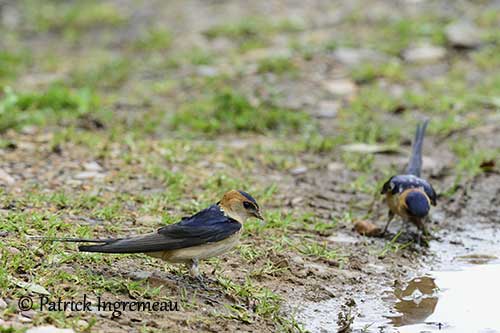
During the breeding season, the male performs some displays by circling while calling around the female. If the female perches, the male joins her and perches nearby while singing. It may sometimes display its tail. The copulation usually occurs inside the nest. They are monogamous. The shape of the nest reduces competition between males for extra-pair copulations.
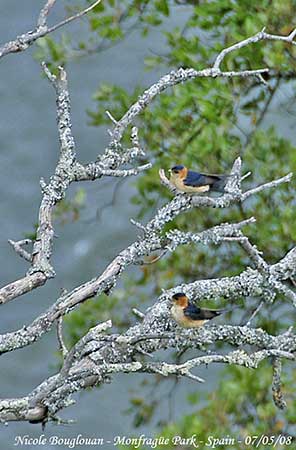
The Red-rumped Swallow is migratory in the N parts of the range, whereas the S populations are mostly resident. They often form large flocks after breeding, with other swallow species and swifts (Apodidae).
This species is vagrant in Europe N to British Islands since 1964, Netherlands, Poland, Scandinavia and Iceland, and also on Azores and Canary Islands in Atlantic Ocean.
The wing shape and the deeply forked tail allow the bird to perform easily aerial manoeuvres while hunting. It often glides, flying at 30-40 km/hour when foraging, and it can reach up to 50-65 km/hour on migration.
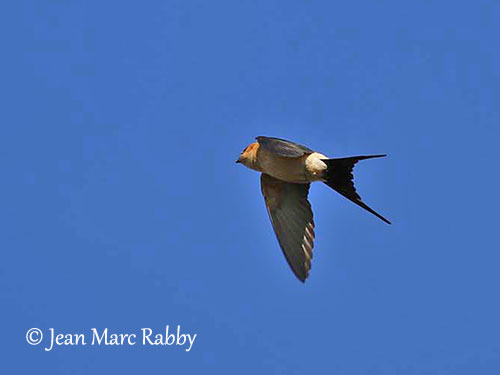
REPRODUCTION OF THIS SPECIES:
The breeding season varies according to the range, but it takes place generally between March and September (April/September in Europe). The Red-rumped Swallow breeds solitary or in loose groups of less than 50 pairs, often in clustered groups or dispersed. The pairs are often aggressive against each other, and the nest entrances are usually at least 30 cm apart, or up to 2-3 metres.
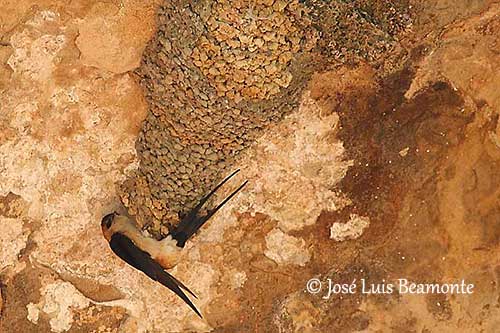
Both adults build the nest and collect mud as a pellet in the bill, usually close to the nest site. The flask-shaped nest has a tubular entrance. It is placed on rocky ledges, buildings, under bridges and caves. It is cemented to the horizontal surface from below. There is a lining of soft grass and feathers inside the nest. They need 5/15 days to build this peculiar structure placed between 5 and 20 metres above the ground.
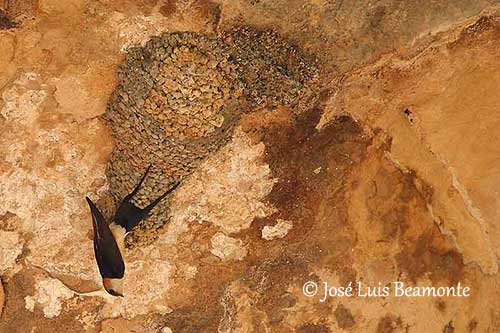
The female lays 2-7 eggs (usually 4-5), but only 2-3 in Sri Lanka and Africa. Both adults incubate during about two weeks, and the chicks are fed by both parents. The young fledge 26-27 days after hatching, but they still depend on parents for food during 5-6 days. They roost in the nest for 2-3 weeks after fledging.
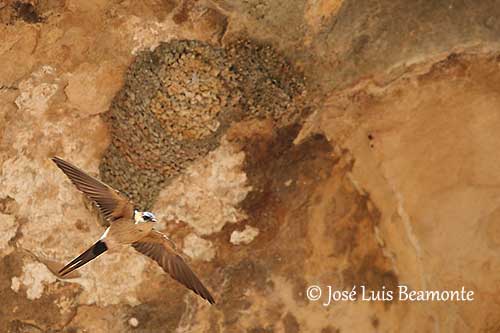
PROTECTION / THREATS / STATUS:
The Red-rumped Swallow has very wide range. It is common throughout it, although being uncommon to locally common in W Africa, and rather local in E Africa.
The population size is unknown but the trend was stable between 1980 and 2011.
The Red-rumped Swallow is currently evaluated as Least Concern.
